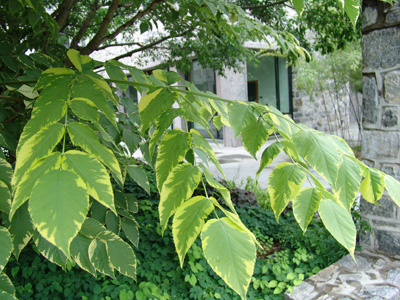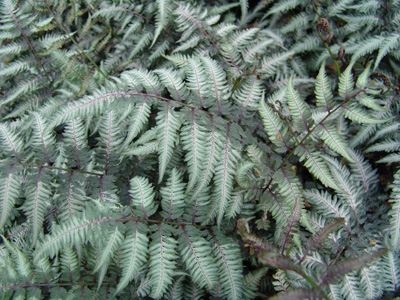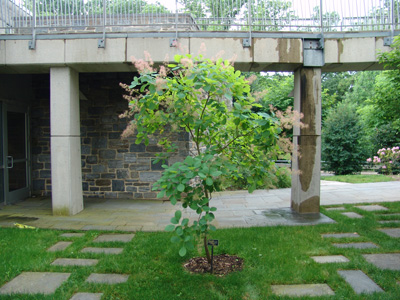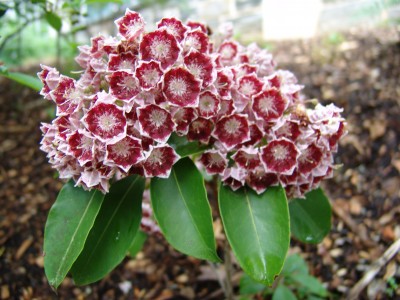Plants of the Week: June 10
Aaron D’Addio, 2013 summer intern, will take over posting Plants of the Week throughout the duration of his time with the Scott Arboretum. We look forward to sharing the plants that catch Aaron’s eye. Here is his first post.
 Aralia elata ‘Aureovariegata,’ commonly known as variegated Japanese aralia or angelica tree is a small tree/large shrub that features green oval leaflets splashed with yellow margins. Large clusters of white panicles appear in late summer followed by purple spherical fruit. Beware of the thorny stems. This plant attracts bees, butterflies, and birds. Japanese aralia gets purple or orange fall foliage and prefers sun/partial shade in well-drained soil. Photo Credit: Aaron D’Addio
Aralia elata ‘Aureovariegata,’ commonly known as variegated Japanese aralia or angelica tree is a small tree/large shrub that features green oval leaflets splashed with yellow margins. Large clusters of white panicles appear in late summer followed by purple spherical fruit. Beware of the thorny stems. This plant attracts bees, butterflies, and birds. Japanese aralia gets purple or orange fall foliage and prefers sun/partial shade in well-drained soil. Photo Credit: Aaron D’Addio
Garden Location: Cosby Courtyard
 One can easily tell why Athyrium ‘Pewter Lace’ was named the pewter lace Japanese painted fern. Each leaf looks like a painter’s work of art using metallic pewter colors on lace-textured leaf margins. This plant features dark maroon colored stem midribs that dramatically contrast with the light green foliage painted over with silver. Japanese painted fern thrives in partial to full shade gardens with moist, organic soil. It forms dense clumps and slowly spreads through rhizomes. Photo Credit: Aaron D’Addio
One can easily tell why Athyrium ‘Pewter Lace’ was named the pewter lace Japanese painted fern. Each leaf looks like a painter’s work of art using metallic pewter colors on lace-textured leaf margins. This plant features dark maroon colored stem midribs that dramatically contrast with the light green foliage painted over with silver. Japanese painted fern thrives in partial to full shade gardens with moist, organic soil. It forms dense clumps and slowly spreads through rhizomes. Photo Credit: Aaron D’Addio
Garden Location: Harry Wood Garden
 When flowering, Cotinus obovatus appears to be on fire. The American smokebush, or Chittamwood, produces tan flowers followed by pink/purple long panicle plumes far into the summer that sway with the breeze, resembling clouds of smoke. These fluffy puffs can often be seen being taken for a ride by the wind. This is a native plant that can either be a large shrub or small tree. If desired, it can be cut back to the ground each year to create a sizeable shrub form, however it will not flower. Foliage turns a lovely scarlet in autumn. American smokebush is drought-tolerant, disease-resistant, and prefers well-drained soils and full sun. Photo Credit: Aaron D’Addio
When flowering, Cotinus obovatus appears to be on fire. The American smokebush, or Chittamwood, produces tan flowers followed by pink/purple long panicle plumes far into the summer that sway with the breeze, resembling clouds of smoke. These fluffy puffs can often be seen being taken for a ride by the wind. This is a native plant that can either be a large shrub or small tree. If desired, it can be cut back to the ground each year to create a sizeable shrub form, however it will not flower. Foliage turns a lovely scarlet in autumn. American smokebush is drought-tolerant, disease-resistant, and prefers well-drained soils and full sun. Photo Credit: Aaron D’Addio
Garden Location: Glade Garden
 Kalmia latifolia ‘Bullseye’ gets stunning cup-shaped flower clusters. Also known as mountain-laurel, calico-bush, and spoonwood, it is a species in the blueberry family, Ericaceae. Each flower resembles a bullseye with a light pink center, maroon band, and a light pink margin. This is an evergreen, native plant, the state flower of Pennsylvania, and thrives especially in well-drained, acidic, organic soils. ‘Bullseye’ mountain laurel is drought-tolerant and performs well in full sun to full shade. Emerging leaves are bronze. Foliage is dark green, oblong, pointed, and glossy all year long with purple/red stems. Photo Credit: Aaron D’Addio
Kalmia latifolia ‘Bullseye’ gets stunning cup-shaped flower clusters. Also known as mountain-laurel, calico-bush, and spoonwood, it is a species in the blueberry family, Ericaceae. Each flower resembles a bullseye with a light pink center, maroon band, and a light pink margin. This is an evergreen, native plant, the state flower of Pennsylvania, and thrives especially in well-drained, acidic, organic soils. ‘Bullseye’ mountain laurel is drought-tolerant and performs well in full sun to full shade. Emerging leaves are bronze. Foliage is dark green, oblong, pointed, and glossy all year long with purple/red stems. Photo Credit: Aaron D’Addio
Garden Location: At the end of the Stormwater Stairs in the Glade Garden





Terri holland
Posted at 18:23h, 15 JuneWow this looks really nice. I hope your having a lot of fun. The plants look really nice.
Lucy Tharp
Posted at 20:55h, 15 JuneI Love this page.
Kalmia latifolia ‘Bullseye’ is my favorite.
thanks for the info
Aaron D'Addio
Posted at 15:05h, 18 JuneThank you! I love working here! Kalmia latifolia ‘Bullseye’ is my favorite one too!
Angela Johnsen
Posted at 18:54h, 18 JuneGorgeous Kalmia, Aaron! Thanks for sharing some of your favorites! Looking forward to more additions!
Aaron D'Addio
Posted at 13:57h, 24 JuneThank you Angela! Check back here every week for 4 new plants!